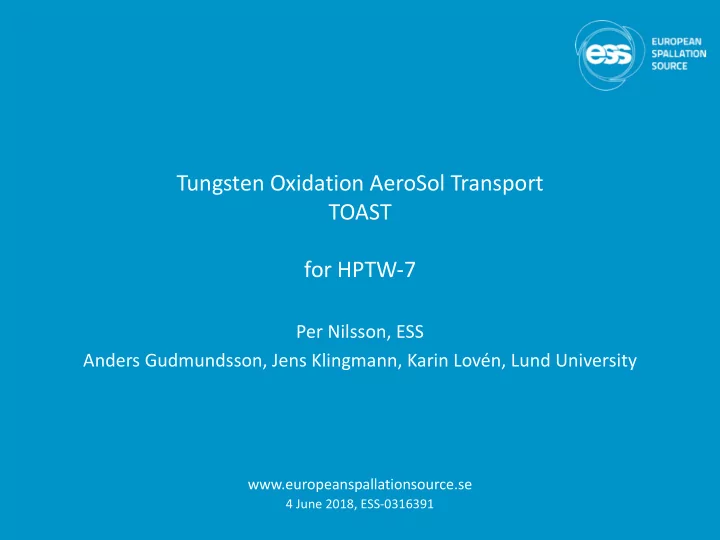

Tungsten Oxidation AeroSol Transport TOAST for HPTW-7 Per Nilsson, ESS Anders Gudmundsson, Jens Klingmann, Karin Lovén, Lund University www.europeanspallationsource.se 4 June 2018, ESS-0316391
Contributions LTH Energy Sciences Laboratory, Manufacturing, Temperature measurements, Seeding, Project management, etc Prof. Jens Klingmann, Martin Carlsson LTH Ergonomics and Aerosol Technology Aerosol measurements Prof. Anders Gudmundsson, Karin Lovén, Louise Gren LTH Production and Materials Engineering Inductive heating Adj. Prof. Tord Cedell, Fredrik Lundström, Ville Akujärvi ESS Bilbao Tungsten samples 2
Outline • Background Accident scenario • Experiments Setup Results • Implications • Lessons learned • Open issues 3
Background
ESS Target P mean = 5 MW f = 14 Hz △ T max /pulse = 100 ◦ C 36 sectors => 2300 ◦ C / min 5
Postulated scenario: Lost cooling, beam on No safety system Relief 1. Cooling lost 2. Temp increases Target opens He coolant lost 3. Pressure breaks monolith vessel confinement NBW 4. Moderator water released & evaporates 5. Tungsten exposed Oxidises and release 6. Loss of PBW cooling -> Failure, beam stop Oxygen source: Air ingress or Cooling water vapour 6
Experiment Scope • How much tungsten becomes airborne by tungsten oxidation at high temperatures, > 1400 C? • Measure Airborne Release Fraction, ARF = mass fraction of the oxidised amount that is airborne after passage through the system Oxidised 0.5% 1 Estimate before TOAST 7
Experiment Setup 8
Vessel configuration Outlet Air Inlet Insulation Pipe Window cooling ~0.5 m/s Heating coil IR thermometer Sample Stainless Thermocouple Sacrifice
TOAST setup Flow Filter control Impactor TC2 DMS2 Aerosol 3 * 1 m, 1.5” Measurements DMS1 TC1 Flange Sample Pressurised air Inductive T IR Heating 10
Experimental Results 12
After Test 11 (~1700 C) 30 g in vessel Looking down onto block Settling in horizontal pipe 55 g in filter -> 38 % ARF up to 0.46 116 g recession 14
Comparing recession to literature (Test 3) 120s 260s Bartlett, R. W., Tungsten and Molybdenum Oxidation Kinetics at Extremely High Temperatures, US Air Force, ML-TDR-64-290, 1964. (120 s + 260 s) * 5 mg/cm 2 s * 35 cm 2 ~ 66 g (74 g measured) 16
Measurements Test 11 Temperature and particle concentration Saturation, rarely above 100 g/m 3 17
Transmission Electron Microscopy (Test 13) Agglomerates of crystal primary particles Far from spherical 18
Implications 19
Implications in accident analysis Higher ARFs (from 0.005 to 0.5), gave high doses => Necessary to remove unnecessary concervatism, e.g.: - Avoid high temperatures - Decrease available oxidant - Limit transport path 20
Implications in licensing process • Notified regulators (SSM) immediately • Delayed decisions on emergency planning • Continuous updates • SSM approved source terms for emergency planning 21
Lessons learned 22
Lessons learned • Numerous in technical details Steam may e.g. condense • Do not extrapolate, use experiments at relevant conditions: We did, but drew preliminary conclusions to early • Openness is crucial but difficult: The findings may seem alarming, but are results of systematic work and do finally not have major implications. This is delicate to communicate during the work, internally as well as externally. 23
Open issues 24
Under investigation • Particle sizes and agglomeration • Deposition • Saturation => Model for application in transport 25
Questions? 26
The End 27
Recommend
More recommend